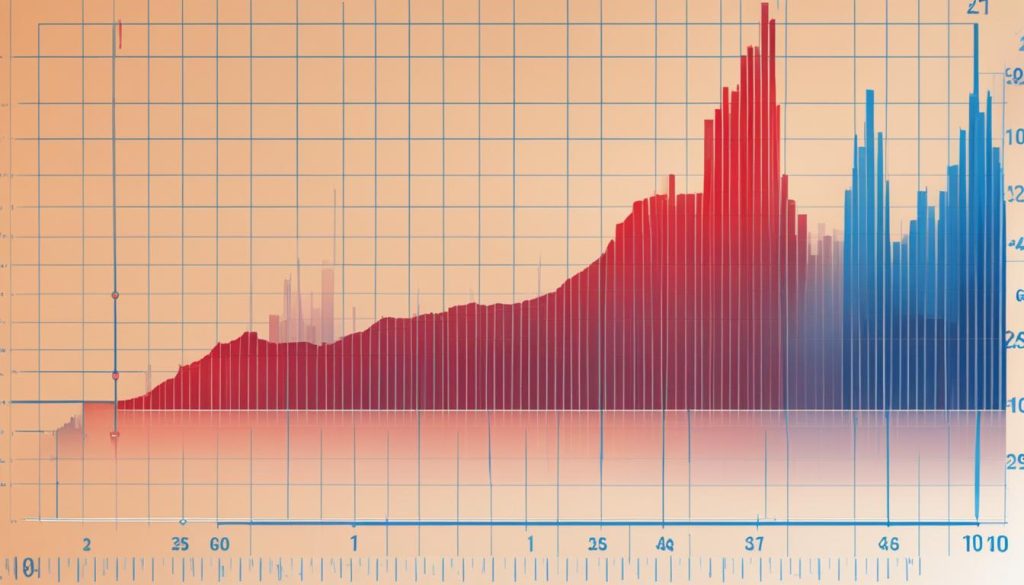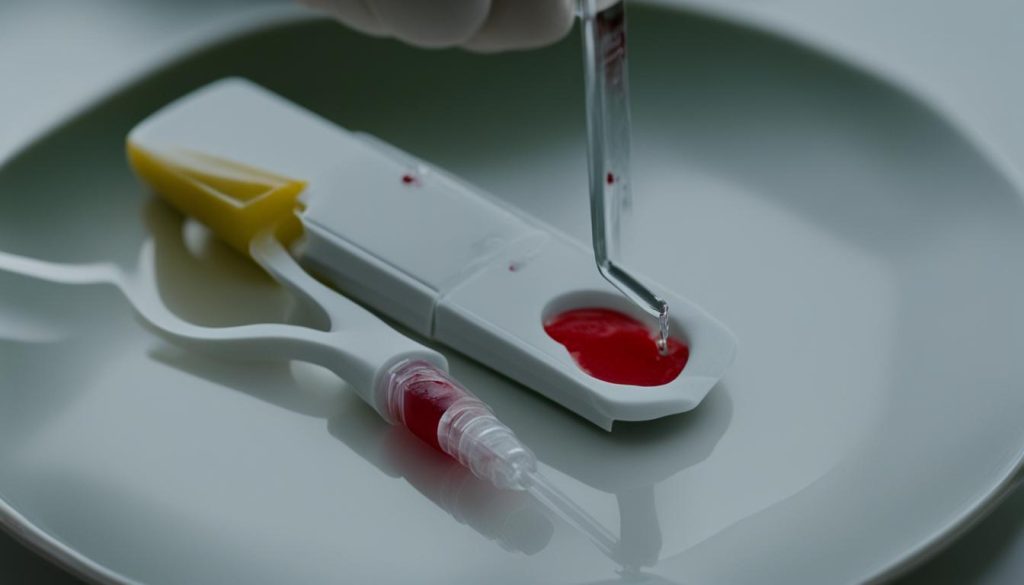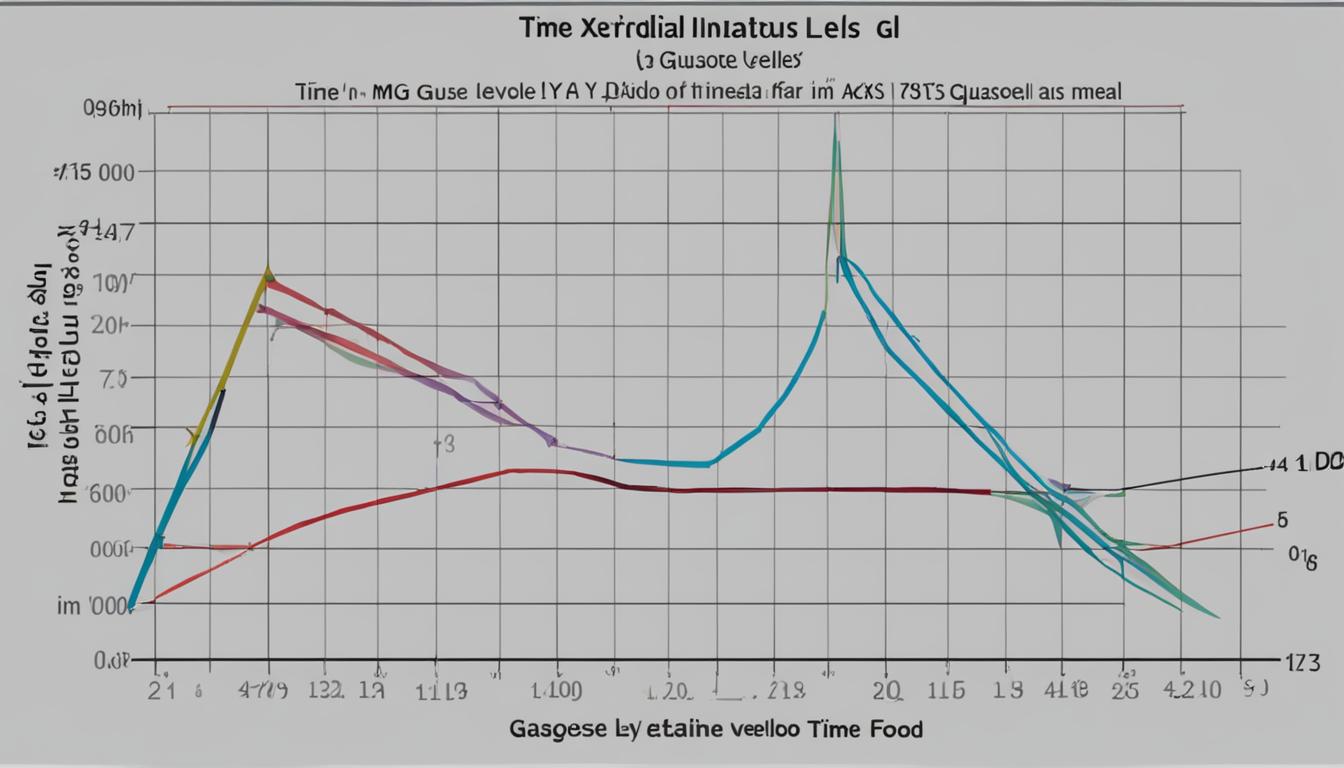Managing blood sugar levels is an essential aspect of diabetes care. Understanding how blood sugar levels fluctuate throughout the day, especially after eating, can help individuals with diabetes make informed decisions about their diet and medications. In this article, we will explore what constitutes a normal blood sugar level immediately after eating, commonly referred to as postprandial blood sugar readings.
Postprandial blood sugar readings provide valuable information about how the body processes and responds to food. By monitoring these levels, individuals can gain insights into their blood glucose control and make adjustments to their diabetes management plan.
So, what are the normal glucose levels after meals? The target blood sugar level two hours after eating for adults without diabetes should typically fall between 90-140 mg/dL. This range may vary depending on factors such as age, diabetes type, insulin usage, and pregnancy. For adults with diabetes, the goal is to maintain a blood sugar level under 180 mg/dL two hours after eating, regardless of insulin usage. Pregnant adults with gestational diabetes should aim for a blood sugar level under 140 mg/dL one hour after eating and 120 mg/dL two hours after eating.
Monitoring blood sugar levels after meals is crucial for individuals with diabetes. By keeping a close eye on these readings, individuals can maintain tighter control over their blood sugar levels and identify any patterns or triggers that may affect their glucose management. It is important to share this information with healthcare providers to ensure a comprehensive diabetes management plan.
Why Do Glucose Levels Matter to Your Health?
Glucose levels play a vital role in overall health, particularly for individuals with diabetes. Monitoring blood glucose levels is crucial in preventing the risk of hyperglycemia, which can lead to serious complications such as vision loss, kidney disease, heart attack, or stroke.
After eating, measuring blood glucose levels provides valuable insights into the impact of specific foods on blood sugar. This information empowers individuals to make informed dietary choices, aligning their eating habits with their health goals. By understanding and managing glucose levels effectively, individuals can work towards maintaining optimal health and reducing the risks associated with diabetes.
Regular monitoring of blood glucose levels in conjunction with diabetes management efforts is essential for sustained health and well-being. With the right knowledge and strategies, individuals can take control of their glucose levels and proactively safeguard their long-term health.
The Importance of Monitoring Blood Glucose Levels
Monitoring blood glucose levels allows individuals to:
- Assess their current blood sugar status
- Identify patterns and trends in their glucose levels
- Evaluate the impact of different foods on blood sugar
- Make informed decisions about their diet and lifestyle
- Take necessary actions to maintain optimal glucose levels
By regularly monitoring blood glucose levels, individuals can gain a better understanding of how their body responds to various factors and make adjustments to their diabetes management plan accordingly.
Managing Glucose Levels for Optimal Health
Effective management of glucose levels encompasses a comprehensive approach that includes:
- Adhering to a well-balanced diabetes-friendly diet
- Engaging in regular physical activity
- Taking prescribed medications as directed
- Practicing stress management techniques
By following these strategies and making lifestyle modifications, individuals can work towards maintaining optimal glucose levels, mitigating the risks associated with diabetes, and promoting better overall health.

What to Eat to Better Regulate Your Blood Sugar?
When it comes to blood sugar regulation and diabetes management, making healthy food choices is essential. Certain foods can cause blood sugar levels to spike, while others have a minimal impact. By incorporating the right foods into your diet, you can better regulate your blood sugar and maintain optimal health.
Carbohydrates play a crucial role in blood sugar regulation. Simple carbohydrates, such as refined sugars and white bread, are quickly broken down and absorbed, leading to a rapid increase in blood sugar levels. On the other hand, complex carbohydrates and fiber are digested more slowly, resulting in a gradual rise in blood sugar.
The glycemic index (GI) is a useful tool for categorizing foods based on their effects on blood sugar levels. High-GI foods cause significant spikes in blood sugar, while low-GI foods have a lesser impact. By choosing low-GI foods, you can better regulate your blood sugar levels.
Here are some examples of low-GI foods that can be included in your diet:
- Whole grains like brown rice, quinoa, and whole wheat bread
- Fruits such as apples, berries, and oranges
- Vegetables like broccoli, spinach, and carrots
- Lean proteins including chicken, fish, and tofu
These foods are not only low in GI but also provide essential nutrients, fiber, and antioxidants that support overall health.
By incorporating these healthy choices into your meals, you can better manage your blood sugar levels and reduce the risks associated with diabetes. Remember to consult with your healthcare provider or registered dietitian for personalized guidance, as individual dietary needs may vary.
Sample Table: Glycemic Index of Common Foods
| Food | Glycemic Index |
|---|---|
| White bread | 70 |
| Brown rice | 50 |
| Apple | 39 |
| Watermelon | 72 |
| Carrots | 39 |
| Broccoli | 10 |
The Best Time to Check Blood Sugar
Regular blood sugar monitoring plays a crucial role in diabetes management. By monitoring blood sugar levels, individuals can gain valuable insights into how their food choices, medication usage, and physical activity impact their glucose levels. The frequency of blood sugar checks may vary depending on the individual’s diabetes type, medication usage, and overall health.
Typically, it is recommended to check blood sugar levels one to two hours after eating. This timing allows individuals to assess how their body processes the glucose from their meal. By checking blood sugar levels at this time, individuals can make informed decisions about their future dietary choices, such as adjusting portion sizes or choosing different types of carbohydrates.
However, it’s important to note that specific monitoring times for blood sugar levels may differ based on a person’s unique circumstances. For example, individuals with gestational diabetes may need to check their blood sugar levels at different times of the day to ensure the well-being of themselves and their baby. Similarly, individuals with hypoglycemia may need to monitor their blood sugar levels more frequently throughout the day to prevent low blood sugar episodes.
It is crucial for individuals to follow their healthcare provider’s recommendations for blood sugar monitoring. Healthcare providers can offer personalized guidance based on the individual’s specific health needs and diabetes management plan. By regularly checking blood sugar levels and making any necessary adjustments to their diabetes management plan, individuals can work towards maintaining optimal blood sugar control and overall health.
Benefits of Regular Blood Sugar Monitoring
- Allows individuals to track the effectiveness of their diabetes medication and make any necessary adjustments.
- Provides valuable insights into the impact of different foods on blood sugar levels.
- Helps individuals identify patterns and trends in their blood sugar levels, enabling them to make informed decisions about their diabetes management.
- Allows individuals to detect and address high or low blood sugar levels promptly, reducing the risk of health complications.
Tips for Blood Sugar Monitoring
- Follow your healthcare provider’s instructions for the frequency and timing of blood sugar checks.
- Use a reliable blood glucose meter and test strips to ensure accurate readings.
- Wash your hands before testing to prevent contamination that could interfere with the accuracy of the results.
- Record your blood sugar readings in a logbook or a smartphone app to track your progress over time.
- Share your blood sugar logbook with your healthcare provider during appointments to facilitate discussions about your diabetes management.
- Seek guidance from a healthcare professional if you have any concerns or questions about blood sugar monitoring.
By prioritizing regular blood sugar monitoring and following healthcare provider recommendations, individuals can actively manage their diabetes and make informed decisions about their lifestyle choices.

What to Do When Your Diabetes Medication Isn’t Working?
Managing blood sugar levels plays a critical role in diabetes management. While medication is an important component, it may not always effectively control blood sugar levels. In such cases, it’s essential to explore additional strategies to improve blood sugar control and ensure the long-term health and well-being of individuals with diabetes.
Meal Planning: Following a well-balanced meal plan can significantly impact blood sugar control. One effective method is the plate method, which emphasizes portion control and includes foods from different food groups. This approach helps regulate carbohydrate intake and promotes stable blood sugar levels.
Carb Counting: For individuals taking mealtime insulin, understanding the impact of different foods on blood sugar levels is crucial. Carb counting involves tracking the number of carbohydrates consumed in each meal and adjusting insulin doses accordingly. This technique allows for more precise blood sugar management and better control over post-meal glucose levels.
Nutritional Support: Registered dietitians can provide valuable guidance by conducting nutritional assessments and offering counseling tailored to individual needs. They can help individuals develop personalized meal plans, navigate food choices, and optimize blood sugar control through diet.
Hydration and Physical Activity: Maintaining adequate hydration and incorporating regular physical activity can contribute to better blood sugar control. Staying hydrated helps the body metabolize glucose efficiently, while exercise promotes insulin sensitivity and enhances blood sugar management.

When diabetes medication isn’t effectively controlling blood sugar levels, a comprehensive approach that combines medication, meal planning, and lifestyle changes can produce positive outcomes. By working closely with healthcare providers, individuals with diabetes can develop a personalized diabetes management plan that includes strategies for effective blood sugar control.
| Strategies for Blood Sugar Control | Benefits |
|---|---|
| Well-balanced meal planning (e.g., plate method) | Promotes portion control and stable blood sugar levels |
| Carb counting | Allows for precise insulin dosing and better blood sugar management |
| Nutritional support from registered dietitians | Offers personalized guidance and counseling for optimal blood sugar control |
| Hydration and regular physical activity | Enhances glucose metabolism and promotes insulin sensitivity |
Embracing these strategies empowers individuals to take control of their diabetes management and achieve better blood sugar control. It’s important to remember that every person’s diabetes journey is unique, and consulting healthcare professionals ensures personalized care and support in finding the most effective diabetes management plan.
How to Grocery Shop if You Have Diabetes?
Grocery shopping plays a vital role in managing diabetes. By selecting the right foods and ingredients, you can create a diabetes-friendly diet that supports blood sugar regulation and overall diabetes management. Here are some helpful grocery shopping tips:
1. Focus on Nutrient-Dense Foods
When grocery shopping for diabetes, prioritize nutrient-dense foods that provide essential vitamins, minerals, and fiber. Choose whole grains like quinoa and brown rice, lean proteins such as skinless chicken or fish, and a variety of fruits and vegetables. Incorporate low-fat dairy products and healthy fats like avocados and nuts into your shopping list.
2. Read Food Labels
Develop the habit of reading food labels to identify hidden sugars and make informed choices. Check the total carbohydrate content and look for products with minimal added sugars. Opt for low-sugar or sugar-free options whenever possible.
3. Plan Meals in Advance
Plan your meals in advance to ensure you have the necessary ingredients. This reduces the likelihood of making impulsive or unhealthy choices while shopping. Create a grocery list based on your meal plan to stay organized and save time at the store.
4. Choose Fresh, Unprocessed Foods
Whenever possible, select fresh, unprocessed foods over packaged or processed options. Fresh produce, lean meats, and whole foods are generally lower in added sugars, sodium, and unhealthy fats. Incorporating these foods into your diet supports a healthier lifestyle.
5. Consult with Healthcare Providers or Registered Dietitians
If you have diabetes, it’s important to consult with your healthcare provider or a registered dietitian for personalized recommendations and guidance on grocery shopping. They can help you create a diabetes-friendly meal plan, suggest appropriate portion sizes, and address any specific dietary concerns you may have.
By following these grocery shopping tips, you can make healthier choices and create a diabetes-friendly diet that supports your diabetes management goals.

Conclusion
Maintaining normal blood sugar levels after eating is crucial for individuals with diabetes to prevent long-term health complications. By understanding their target blood sugar ranges and making appropriate dietary choices, individuals can effectively manage their blood sugar levels.
Regular blood sugar monitoring, medication adherence, and lifestyle modifications such as regular physical activity and portion control can all contribute to better blood sugar control. Consulting with healthcare providers, including registered dietitians, can provide individuals with personalized strategies to maintain optimal blood sugar levels and overall health.
With proper management, individuals with diabetes can reduce the risks associated with the condition and live a healthy, fulfilling life. By prioritizing blood sugar management and diabetes control, individuals can ensure they are maintaining optimal health for the long term.




